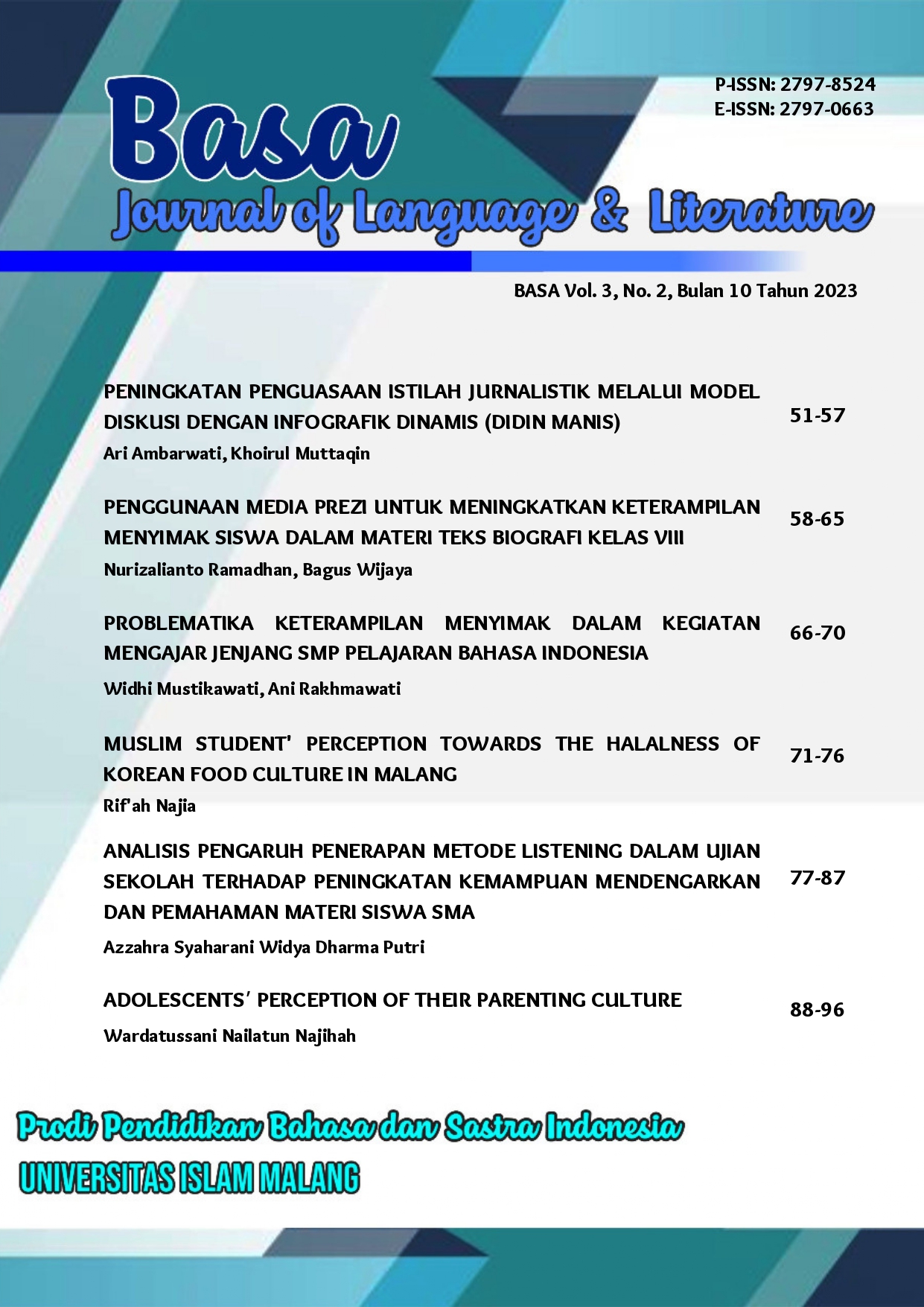PENINGKATAN PENGUASAAN ISTILAH JURNALISTIK MELALUI MODEL DISKUSI DENGAN INFOGRAFIK DINAMIS (DIDIN MANIS)
DOI:
https://doi.org/10.33474/basa.v3i2.20552Keywords:
Improved Group Proficiency, Infographics, Didin Manis Learning ModelAbstract
Journalistic theory is one of the courses given to students of the Language and Literature Education Study Program, semester III at the Faculty of Teacher Training and Education (FKIP) Islamic University of Malang. The research focuses on increasing group proficiency in compiling infographics of journalistic terms through the Didi Manis learning model. This research design uses one-cycle Classroom Action Research (PTK). The results of this study prove that students get a more complex learning experience because they are in two different groups. The results of the infographic made by the group also showed good results with an average value above 80.
References
Ambarwati, Ari. (2018). Bahasa Jurnalistik. Buku Diktat. FKIP UNSMA.
Arikunto, Suharsimi. (2010). Prosedur Penelitian Suatu Pendekatan Praktik. Jakarta: PT Rineka Cipta
Famsah, Saefuddin & Khristin Sri Utami Nardiyana. (2022). “Efektivitas Model Pembelajaran Hyberd dalam Pembelajaran Menulis Cerpen Siswa Kelas XI SMAIT Al-Uswah Bangil”. Jurnal Basa 2 (2). 64-70.
Klein, Ernest. (1971). Klein's Comprehensive Etymological Dictionary of The English Language. Amsterdam: Elsevier Publishing Company.
Lankow, Jason, et al. (2012). Infographics : The power of Visual Storytelling. New Jersey: Wiley Publishing.
Ozdamli, Fezile, et al. (2016). “Statistical Reasoning of Impact of Infographics on Education”. Procedia Computer Science, (14) 4, 1197-1291.
Shapiro, I., Brin, C., Bedard-Brule, I. And Mychajlowycz, K. (2013). “Verivication as a Strategic Ritual.” Journalism Practice 7 (6): 657-673.
Simicklas, Mark. (2012). The power of Infographic : using Pictures to Communicate and Connect With Your Audience. Indianapolis : Que Publishing.
Stalph, F. (2018). “Classifying Data Journalism.” Journalism Practice 7 (6), 1332--1350.
Steensen, S & Ahva, L. (2015). “Theories of Journalism in a Digital Age: An Exploration and Introduction.” Digital Journalism 3 (1), 1-18.
Downloads
Published
Issue
Section
License
Copyright (c) 2023 khoirul M muttaqin, Ari Ambarwati

This work is licensed under a Creative Commons Attribution-ShareAlike 4.0 International License.
-
Authors who publish with this journal agree to the following terms:
- Authors retain copyright and grant the journal right of first publication with the work simultaneously licensed under a Creative Commons Attribution License that allows others to share the work with an acknowledgement of the work's authorship and initial publication in this journal.
- Authors are able to enter into separate, additional contractual arrangements for the non-exclusive distribution of the journal's published version of the work (e.g., post it to an institutional repository or publish it in a book), with an acknowledgement of its initial publication in this journal.
- Authors are permitted and encouraged to post their work online (e.g., in institutional repositories or on their website) prior to and during the submission process, as it can lead to productive exchanges, as well as earlier and greater citation of published work (See The Effect of Open Access).

BASA is licensed under a Creative Commons Attribution-ShareAlike 4.0 International License.
Based on a work at http://riset.unisma.ac.id/index.php/BASA/index


